 Your first shot on any par four or par five sets up the rest of the hole: are you pitching back into the fairway or attacking the flag? Do you have a wedge or a 6-iron in your hands?
Your first shot on any par four or par five sets up the rest of the hole: are you pitching back into the fairway or attacking the flag? Do you have a wedge or a 6-iron in your hands?
Pros and high-level amateurs have been repeating the mantra “high launch, low spin” for a few years now. In January, we even published a chart showing optimum launch angles and spin rates. Great, you’re thinking to yourself: “I’ll get fitted for a driver and soon I’ll be crushing the ball off the tee, long and straight.” And you may… so long as you can get fitted.
I spent a day with the guys of the East Coast Acushnet (Titleist, FootJoy, etc.) Science Van at Tam O’Shanter of Pennsylvania and watched several fittings. The next day, I underwent a fitting myself as they ventured to Kahkwa Club here in Erie, PA. This is my first-hand account of that experience.
Arrival
The Titleist Science Van carries a crew of three and a slew of equipment from course to course, driving range to driving range. Its primary purpose is to gather swing data from golfers across the country and to educate the public on launch conditions. A three-man team – the eastern half of the United States is tackled by David Durham, Jeff Beyers, and Jason Barber – can go through sixteen half-hour appointments (with an hour for lunch) per day, five to six days per week.
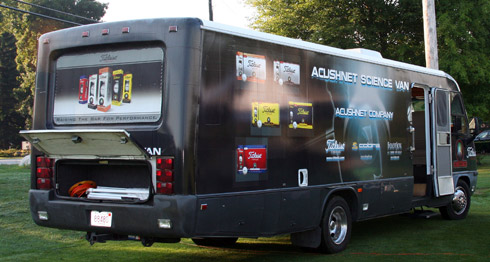
This particular van will be retired at the end of this year. David, Jeff, and Jason are excited to get a new one soon. With over 250,000 miles, this van has served them well!
If you’re being fit, you’ll see the van as you pull up. The fitting equipment draws its power from the van, so it’s never far away.
Most fittees arrive ten to fifteen minutes before their scheduled times to loosen up, hit a few shots with their drivers on the range, and to get a feel for their swing that day. Titleist representative David Durham says that “it’s important that a player hit the ball as consistently as possible and not try to do things that aren’t a part of their normal swing. It helps us to get better data and that, in the end, helps the player the most. We test players that are 6 handicaps and lower (recommended) and sometimes get players up to the 10 handicap level. Any higher than that and a consistent swing is sometimes if not always impossible. The day I was fit, for example, players were driving into a strong headwind. “We do see players trying to hit the ball harder when there’s wind, but we try to remind them that they need to put their normal swing on it to get the best results.”
Player Profiles
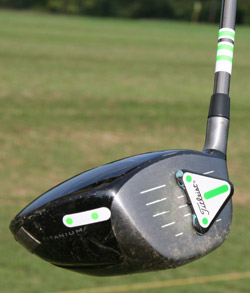 Players that haven’t already filled out a player profile are then asked to do so. The Player Profile asks for basic information like your name, location, right- or left-handedness, and your handicap. It then gets into specific information, such as:
Players that haven’t already filled out a player profile are then asked to do so. The Player Profile asks for basic information like your name, location, right- or left-handedness, and your handicap. It then gets into specific information, such as:
- Type of ball you play (and why)
- Your current driver (loft, shaft, length, and the reasons you use it)
- Your typical ball flight and trajectory
- Your average carry and roll
The player profiles not only help the Science Van guys get you fitted more quickly, but they also provide some telling information. “You wouldn’t believe how far off some guys are when they put down their average driving distance. The higher the handicap, the further off they are.” The information from your fitting sheet is entered into the computer, where it’s later used by Titleist in the creation of new clubs and technologies.
Getting Fit
Player profile safely entered into the computer, reps next “sticker” a player’s driver by putting a sticker with two green dots on the toe, a sticker with three green bands on the hosel, and a plastic triangle with two green dots and a line on the face. The triangle helps to measure loft and the dots and bands act as a sort of bar code for the driver. “Every time you swing that driver through the hitting area, the machine will know that it was your driver,” says Jason Barber. “Every Titleist driver we have for testing has already been stored in the system, so we don’t have to enter the specs every time it’s swung.” It makes the testing process that much smoother.
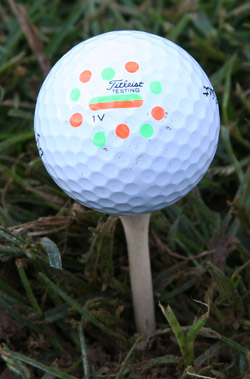 Once your driver is put into the system, you’re given the chance to hit a few balls with your driver. Titleist representatives tee up each ball for you at the tee height you normally use. Not having to put your own ball on a tee feels like a luxury, but it’s a necessity for the reps: they have to align a specially marked ball so that the camera can pick up the painted-on orange and green markings.
Once your driver is put into the system, you’re given the chance to hit a few balls with your driver. Titleist representatives tee up each ball for you at the tee height you normally use. Not having to put your own ball on a tee feels like a luxury, but it’s a necessity for the reps: they have to align a specially marked ball so that the camera can pick up the painted-on orange and green markings.
While one rep is putting the ball on the tee, another is sitting behind the computer managing all of the data that comes in, and a third is in the van talking with the last person fitted. The computer operator – the true “fitter” in this scenario – asks the player questions such as “why did you choose your current driver?” or “is that your typical ball flight?” after a decent shot.
After a few good drives with the player’s current driver, the computer operator will look at the numbers – launch angle, ball speed, and spin rate primary among those – to determine which club and shaft to try next. “The fitting process is all about trial and error. We have general guidelines, but finding the perfect combination takes some effort,” Jason Barber said. “A typical fitting is four to five different drivers and shafts.”
Titleist drivers currently come in two head shapes (905S and 905T), several lofts (7.5° through 10.5° being fairly common), and a variety of shafts. The fitter won’t just ask the rep teeing up the balls to grab a “905S with 9.5° and a YS-6 Stiff.” Instead, he’ll speak in code. The fitters in this van are baseball fans, and have designed a series of baseball terms that refer to each driver head, loft, shaft, stiffness, and length. The shafts too are blacked out so the player being fit does not know what they’re hitting.
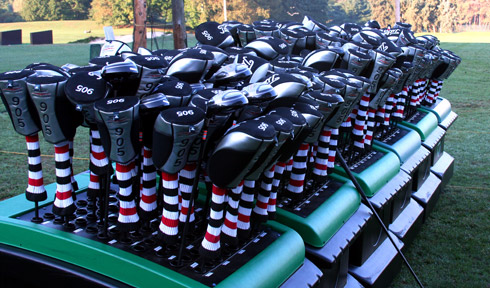
Titleist drivers in nearly every combination of length, loft, shaft, and head type are carted from course to course. Each slot is marked in a code and the shafts are blacked so that players can’t be sure what they’re hitting.
“If players know what they’re hitting, they may change their swing,” says Beyers. “If they have an 8.5° driver with a stiff shaft and we give them a 10.5° driver with a regular shaft, you can imagine how some guys would react.” In other words, the fitters want you to make a consistent swing, not change your swing because they’ve given you a driver with more or less loft, length, or staff stiffness.
“The fitting process is as much art as it is true science,” explains Durham. “Two players with the same fault, say, too much spin, may require two very different solutions.” For example, the fitting machine records information such as the attack angle. While the reps like to see an attack angle between 0 and 2 degrees, several players were hitting down on their drivers, producing an attack angle between -7 and -1 degrees. That creates too much spin creates, which reduces carry, which reduces overall distance. But another player may create too much spin by using a shaft that’s too flexible or a head with too much or too little loft.
Walking that fine line between art and science – the art of fitting and the science of maximizing the data captured by the computer – fitters cycle through a few driver/shaft combinations. They follow guidelines – the 905T is a higher-spin head than the 905S, and it’s also got a bit more weight in the heel. A player whose misses are to the right or who has too little spin with an “S” may be moved to a “T.” Players missing shots on the heel with a 45″ driver may be given a 44″ driver to test. Sometimes, the guidelines can fail: the YS-6 is a fairly tip-flexible shaft that suits slower swing speeds well, yet one fittee with a 115 MPH swing speed was fit with a YS-6 because he paused at the top of his backswing, allowing the YS-6 time to catch up. Likewise, Tour players swing hard and favor the YS shafts, but their smooth tempos allow the shaft to function properly. Throughout the process, players are encouraged to offer their feedback “this club feels lighter,” “the shaft feels pretty whippy,” and “that was a bad swing, don’t count that one” are all valuable bits of information.
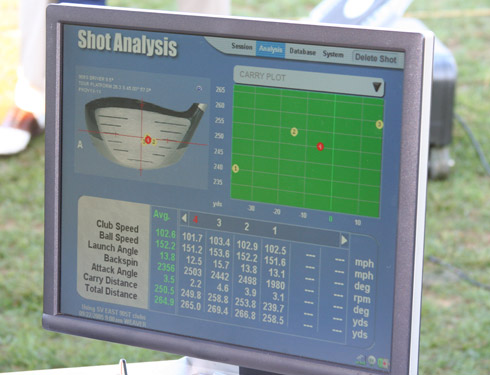
The quick analysis screen shows the pertinent information: club and ball speed, launch and attack angles, backspin, and carry and total distance. It also displays the quality of contact and a carry plot. In this photo, you can see that for 152 MPH ball speed, 265 yards of average carry are about optimal because 13.8° with 2400 RPM backspin are good numbers.
Not every hunch is right, and occasionally a player will hit a driver so poorly that the fitter will simply cross it off the list and go in a completely different direction. Though the machine records a lot of information (like club face angle and path at impact, sidespin, and shaft droop), the information that primarily affects driver distance and accuracy is rather short:
- Quality of contact (where on the driver face was the ball hit)
- Club and ball speed
- Launch angle
- Backspin
- Attack angle
These numbers generate two other important numbers: carry distance and total distance. As with all other parts of the process, the numbers are not revealed to the player. “If a player could see that they were swinging only 100 MPH, they might try to swing 105 or 110,” says Durham. “That would throw things off.”
Mishits are taken into account, as most players can’t consistently strike the center of the clubface. Shots low on the clubface generate more spin and a lower launch angle, while shots struck high on the face result in the opposite: less spin and a higher launch angle. “If a player is going to miss, we prefer them to miss high,” said Barber. “Really poorly struck shots we delete or they’d throw off data, but if a player is making consistently bad contact, it could be the length or the weight of the shaft throwing them off.”

A player swings the club through the area behind to the ball, breaking the laser beams and triggering the cameras to take a series of very-high-speed pictures. Within a second, the calculations are done and the results appear on-screen.
Durham adds that after a player is fit with a driver, the player “might ask us if he can try different swings to work the ball or to see if it will hook or block when they swing harder. It is important that they are fit properly on a normal swing but it is also important that they can work the ball if they desire.”
After hitting several driver/shaft/loft/length combinations, the player is taken by his fitter into the van. The rep who was placing balls on the tee and fetching drivers from the racks becomes the computer operator, and the person formerly in the van tees up balls.
Inside the van, the fitter shows the player a brief presentation on the purpose of the Science Van. Contrary to what some may think, the van is not a sales vehicle. Though the local club pro is often around to catch anyone who may want to purchase a new Titleist driver, the Titleist science van fitters are not salespeople. Their purpose, they’ll all tell you, is simply to educate players on launch conditions and to gather data for the development of future drivers.
It is inside the van that the player first sees the data the reps have collected. The fitters do a tremendous job sharing the data without criticism or complaint. Their focus is simply on trying to find the best driver for the swing the player has, not to make swing changes. After explaining the process and purpose, a comparison is made between the baseline driver (the player’s driver) and the recommended driver. Occasionally the player may already have a driver that performs adequately or better than any driver tested, and the fitters make this known in such instances.
A few printouts and a handshake later and the player is out the door equipped, educated, and enlightened.
My Fitting
After watching a day of fittings, it was my turn. Because I had re-aggravated a muscle in my back, my swing was a bit atypical that day, and I was hitting low blocks and fades when my normal shot is a higher draw. I was consistent, however, so for the sake of the article, I went through the fitting as if the weak slappy cut was my normal swing.
My driver is a Titleist 905S, 9.5°, 45.00″, 57.00° lie, with a YS-6 Stiff shaft. Durham asked me what I had been using previously and why I chose this driver, and I said that I had been using a 983K with a YS-6. I chose the 905S because I spun the ball a little too much and my big misses were duck hooks, but I liked the shaft. The 905S has served me well.
I hit a few shots with my driver and averaged 102 MPH in clubhead speed and 149 MPH in ball speed (a 1:1.5 ratio indicates ideal ball/club contact). My ball spin was 3558 – far too high – and my launch angle was only 10 degrees. I carried the ball 234 with my impaired swing and my total distance was only 247 yards. The reason for the high ball spin and low launch angle? My angle of attack was a whopping -5 degrees.

“The Machine” consists of a box with bright strobe lights and several high-speed cameras. A reflector is positioned behind and inside the teed ball, and when the clubhead breaks the laser beam, the machine takes several pictures, calculates launch angle, backspin, attack angle, and more. The data then appears on the screens for human analysis. The entire process takes about half a second.
From my driver, I was first moved to a 905T with a Prolite, both of which should have helped to eliminate the big cut that the sore muscle was causing. They did… to the point of hitting some snipes well left. That driver/shaft combination quickly earned an “X” on the fitting sheet.
The next driver was back in the S family and came with a Speeder shaft. Ball speed climbed to 150 because club speed climbed to 103, but my launch angle dropped to 9.3° and spin dropped to 3025. My carry and total distances were an even worse 229 and 248 yards. The Speeder shaft had done its job – they were attempting to drop the spin – but only at the expense of yardage.
Sticking with the lower-spinning head (the S), the next shaft was the Aldila NV 65. Though I felt that the club was well balanced and that the head didn’t lag as much as some of the other shafts, the ball simply didn’t go where I wanted it to. I was all over the map, and this driver also got an “X” on the fitting sheet.
Finally, I was handed an 8.5° 905S with the Fujikura Tour Platform 26.3 shaft. My ball speed jumped to 154 with a clubhead speed of 104. My angle of attack also dropped to -4°. I think I was simply loosening up a little bit – improved clubhead speed and a swing that was moving ever so slightly back towards normal. My backspin and launch stayed fairly consistent – 3379 RPM and 9.3° – but my carry (247 yards) and total distance (260 yards) improved. I attribute this largely to the loose swing and the improvement in ball speed.
In the end, my current driver and the last tested, the 8.5° Fujikura TP26, were very close in performance. I saw where I was hitting the ball on the clubface, and I learned a great deal about the swing and my mechanics that day. Later that second day, I attended a high school golf match. Having watched some 600 drivers being hit in the past week, I could guess pretty accurately what someone’s launch angle and backspin were as the ball left the clubface.
After my back rested a little more, I played some golf. Mindful of the downward attack angle the fitting had revealed, I moved the ball a little further forward in my stance and concentrated on sweeping the ball from the tee on the upswing (though only a small upswing: again, 0 to 2 degrees is optimal). With a rested back, the slappy cut disappeared and my normal high draw reappeared. My average drive began carrying about 250 yards with a total distance of about 265 to 270 – about ten yards further than during the fitting. Were I to guess, my launch angle and spin would have been about 12° and 2900 RPM, or fairly close to optimal.
In the end, my own fitting didn’t provide me with any changes of equipment, but it did meet the two main goals the science van set out to achieve: it educated me on launch conditions and it allowed Titleist to gather data for future products.
Random Notes
- Jeff Beyers says that though changing the ball can have a dramatic effect on spin (i.e. a high-spin player using a Pro V1 instead of a Pro V1x), it’s something they typically try to avoid. Why? “Because you only hit 14 drives, at the most, per round. You hit a lot more putts, irons, wedges, chips, etc. – it’s more important that the ball be geared towards that part of your game than to driving, because we can usually find a driver that’ll work with the ball you prefer.
- A consistent launch angle and spin rate are the cornerstones of solid driving. Downwind or headwind, soggy or dry, draw or cut, it doesn’t matter: the ideal launch conditions are ideal in all but the most extreme situations. Though players in windy Texas may want to see a lower ball flight than is optimal, Titleist reps do what they can to educate players on the optimal trajectory and spin.
- Players are advised not to get fit for a driver if their swing is “off” that day. They may still go through the fitting process – the information is still valuable to Titleist, after all – but fitting decisions (and eventual purchase decisions) should be made when the player has their most normal swing possible.
- A driver is not all about maximizing distance, but about maximizing playability. That includes accuracy. You might kill a drive with one club/shaft combo, but if your other six swings result in huge duck hooks, it’s not the club for you.
Scheduling an Appointment
If you’d like to schedule an appointment with the Titleist Science Van, this “Ask Titleist” article provides an answer:
Question: I am interested in trying your Titleist Launch Monitor. Is it available to the public?
Answer: The Acushnet Science Van is a broad reaching project that brings launch condition technology to communities and golf clubs around the country to educate individuals about launch condition dynamics. Unfortunately, we are unable to publish the schedule on our website to protect hosting sites from the numerous outside calls.
Talk to your local pro or your local Titleist sales rep. They’ll know where the van is and when you can book an appointment. It may be the best – and most educational – thing you’ll do for your golf game this year.

How much did this fitting cost?
All of Titleist’s fittings (like this) are free. If you’re being fit for a driver in order to purchase one from a pro or a retail store, oftentimes the fitting runs $25 or $50 with the cost applied towards the purchase of irons or a driver.
But again, this and all Titleist Science Van fittings are free.
Do you know if the van comes to Quebec?
Mathieu, word is they don’t venture that far up there, but check with your local pro or Titleist rep and see about getting a fitting at any time. You should be able to schedule a similar one, at least to get your current numbers, quite easily.
sounds like a wet dream comes true… 🙂
I hope they’ll drive by New Jersey one of these days!
FWIW, the Science Van has been discontinued in 2006 in favor of Titleist’s new complete-set “FittingWorks” system.
Is the tour Van scheduled to be in the panhandle area of north Fla or Southeaset Alabama anytime soon?
The van has been replaced by other fitting options. Talk to a local pro for the best advice.